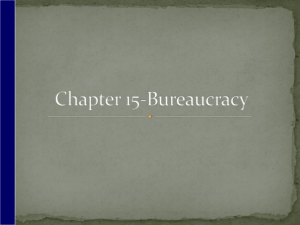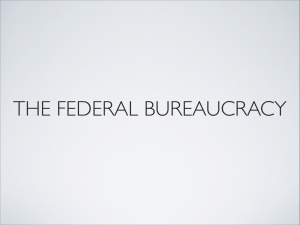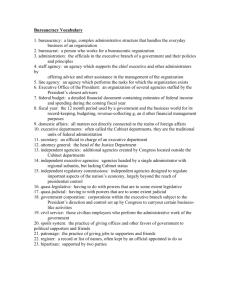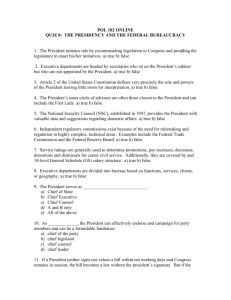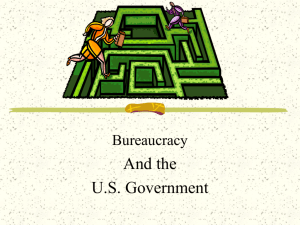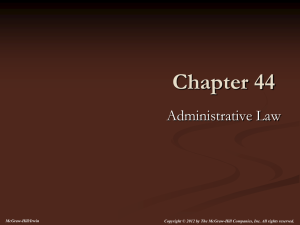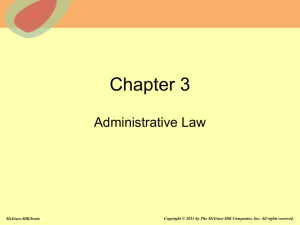Federal Bureaucracy
advertisement
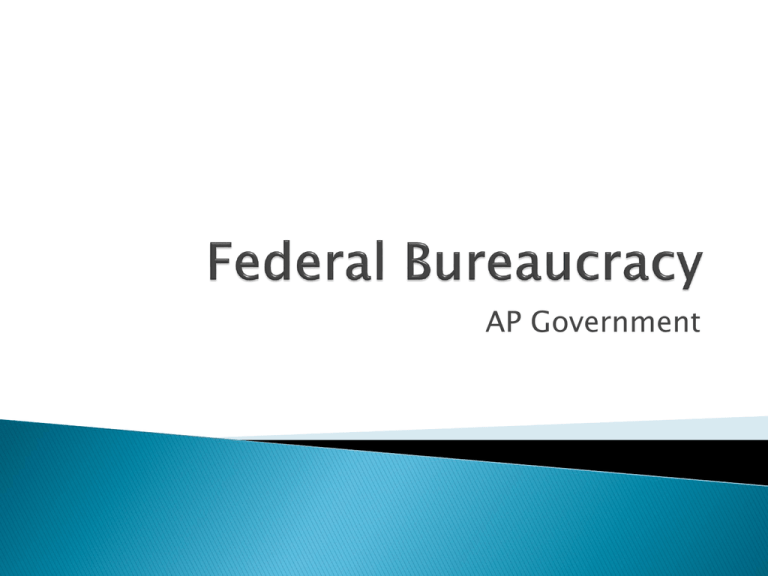
AP Government Began with George Washington ◦ He started with three executive departments Foreign Affairs War Treasury ◦ Foreign Affairs was later changed to State and he added an Attorney General his second term. Post Master General was given a Cabinet position under Jackson. ◦ Westward expansion made this a legitimate move ◦ Jackson used patronage and the Spoils System to reward his supporters. Civil War changed the bureaucracy forever. ◦ It expanded to meet the needs of a country at war with itself Agriculture was added, but it wasn’t official Pension was the same way The Department of Justice was expanded Spoils System got Garfield (not the cat) killed ◦ Pendleton Act resulted Switched from the spoils system to the Merit System Began to use the Civil Service Exams for employment Independent Regulatory Commissions ◦ First was INTERSTATE COMMERCE COMMISSION (ICC) – used to regulate railroad rates. This shifted bureaucratic responsibilities from service oriented to regulation oriented. 1913 Commerce & Labor were added 1914 Federal Trade Commission was added Great Depression led FDR to create more federal agencies (duh!) WWII brought even more! Civil Rights added a couple of more. 9/11 added the most recent one – HOMELAND SECURITY A career government employee Three areas where government employees DON’T have to pass the civil service exam: ◦ Appointed Policy Making positions Secretaries of… Undersecretaries On these, the President appoints/Senate confirms ◦ Independent Regulatory Commissions President Appoints – no Senate Confirmation needed ◦ Low-level, non-policy, patronage positions Secretarial assistants to policy makers It is shrinking due to budget constraints Government is hiring outside contractors to do the work Formal Organizations of the Government ◦ Agencies fall into one of four categories 1. 2. 3. 4. Cabinet Departments Government Corporations Independent Agencies Regulatory Commissions Most government corporations charge for their services: ◦ ◦ ◦ ◦ ◦ U.S. Postal Service Amtrak FDIC TVA Etc. Resemble cabinet departments. These perform a service: ◦ NASA ◦ EPA By not being part of a cabinet department, they have more freedom to develop Created by Congress to be outside the major departments so they can regulate a specific economic activity or interest. ◦ Older ones like the SEC and Federal Reserve Board were created to oversee industries ◦ Newer ones, like OSHA, are more concerned with how the business sector relates to the public. Hatch Act, 1939 ◦ Very extreme. Federal employees were prohibited from making campaign contributions, working for a political party, or campaigning for a candidate Federal Employees Political Activities Act, 1993 ◦ Today they’re allowed to be involved politically with some restrictions. See handout. Max Weber had a profound impact on how bureaucracies SHOULD work: ◦ Model Bureaucracies had 6 Characteristics Chain of command is from the top down Division of labor that utilizes specialized skills Clear lines of authority A goal that determines structure, authority and rules. Employees are treated fairly – clients are served equally Productivity where work is evaluated by established rules Congress established these to make sure that specialization is utilized. In essence they’re turning over part of their power. To study the implementation of laws developed by these organizations we need to look at three models: ◦ IRON TRIANGLE – this has stable relationships and interaction between the members of the bureaucracy ◦ ISSUE NETWORKS – similar to the Iron Triangle, but in addition to the same characters, they have everchanging members – lawyers, consultants, academics, PR specialists, and the courts. ◦ INTERAGENCY COUNCILS – working groups that bring together representatives of different agencies, depts., etc. to coordinate policy making and implementation Example: U.S. Interagency on the Homeless worked with 50+ government agencies to coordinate relief for the homeless. Policy Coordinating Committees (PCCs) – formed to further help form interaction between agencies and depts at the sub-cabinet level ◦ After 9/11, a PCC was formed on Terrorist Financing. Worked with representatives from the depts of Treasury State Defense Justice CIA FBI Recommended asking Saudi Arabian government to take action against terrorist financiers Administrative Discretion ◦ The ability of bureaucrats to make choices concerning the best way to implement congressional intentions ◦ Two formal procedures for this 1. Rule Making 2. Administrative Adjudication Rule Making – this is quasi-legislative and it has the characteristics of a legislative act. ◦ See the handout on How Regulations are Made ◦ Administrative Procedures Act of 1946 set rules for rule-making procedures Public notice of time, place and nature of rule-making proceedings be provided in the Federal Register. Interested parties be given the opportunity to submit written arguments and facts relevant to the rule The statutory purpose and basis of the rule be stated Once rules are written, 30 days must elapse before they take effect. Administrative Adjudication – quasi-judicial process. Board of judges settles disputes over whether a corporation or person is violating a rule or regulation ◦ Examples: Federal Trade Commission EEOC Social Security Judges ◦ All of the decisions by these are reviewable by the Federal Courts if need be Congressional Control ◦ Two types of Oversight Police patrol – proactive, allowing Congress to set its own agenda for programs or agencies to review Fire Alarm – reactive, involves a Congressional response to a complaint (most used) ◦ Power of the Purse – to fund or not to fund…that is the question House Appropriations Committee Government Accounting Office Congressional Research Office Congressional Budget Office Less apparent than Congressional and Presidential Control ◦ Federal judges can issue injunctions or orders to specific Federal Agencies
